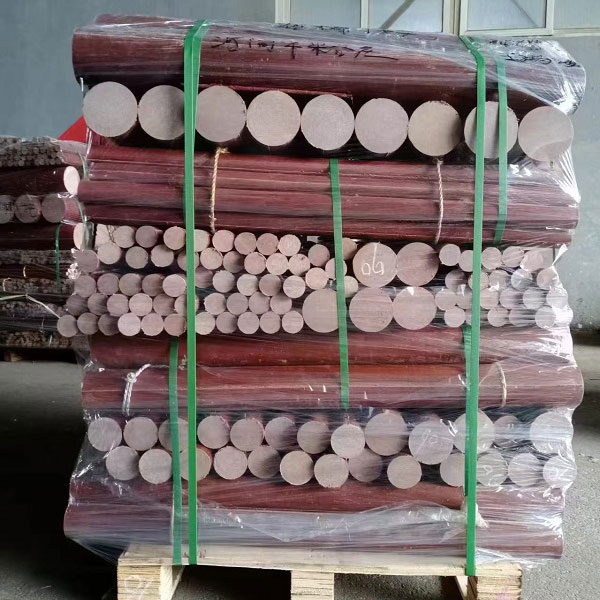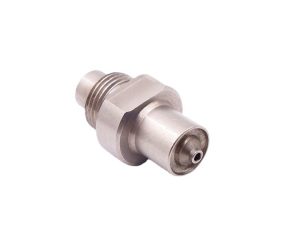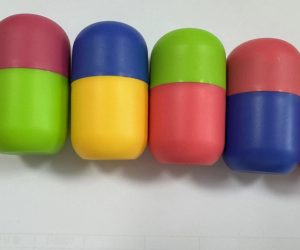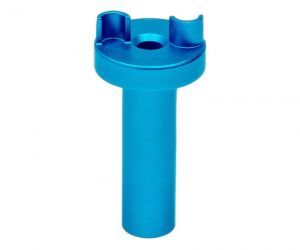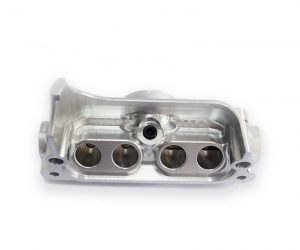1. Introduction: The Critical Role of CNC Machining in Bakelite Part Production
Phenolic resin, commonly known by its trade name Bakelite, has been a cornerstone material in industrial manufacturing for decades. Since its invention in 1907 by Leo Baekeland, Bakelite has been celebrated for its exceptional properties, including outstanding thermal resistance, electrical insulation, and dimensional stability. These characteristics make it an ideal choice for a wide range of applications, from electrical insulators to aerospace components.
However, machining Bakelite - a brittle, heat - resistant thermoset - is no easy feat. Its unique material properties pose significant challenges, such as high brittleness, which can lead to cracking and chipping during traditional machining processes. This is where specialized CNC (Computer Numerical Control) solutions come into play. CNC machining offers the precision, control, and flexibility required to overcome these challenges and harness the full potential of Bakelite.
CNC machining has revolutionized the production of Bakelite parts. By using computer - controlled tools, it can achieve tight tolerances and complex geometries that are difficult or impossible to obtain with conventional machining methods. For Yigu Technology example, in the production of high - precision electrical connectors made from Bakelite, CNC machining can ensure that the holes and slots are drilled with micron - level accuracy, guaranteeing a perfect fit and optimal electrical performance.
In the following sections, Yigu Technology will delve into the technical nuances of precision CNC machining for Bakelite parts. We will explore the material characteristics of Bakelite, the optimization of CNC equipment for Bakelite machining, and the latest process innovations. By integrating real - world data, comparative analysis, and industry best practices, we aim to provide a comprehensive guide for engineers seeking to master Bakelite machining.
2. Material Fundamentals: Understanding Bakelite for CNC Machining
2.1. Key Properties of Phenolic Resin Bakelite
Before diving into the machining process, it's crucial to understand the fundamental properties of phenolic resin Bakelite. These properties directly influence the CNC machining strategy and the quality of the final product.
Thermal Resistance:
Bakelite is renowned for its high thermal resistance. With a heat deflection temperature typically ranging from 150 - 180°C, it can withstand high - temperature environments without significant deformation. For Yigu Technology example, in the manufacturing of electrical components used in high - power transformers, Bakelite's thermal resistance ensures that the parts maintain their shape and integrity even when exposed to the heat generated during operation. However, this high thermal resistance also presents challenges during machining. The heat generated during cutting can cause thermal stress in the Bakelite, leading to cracking if not properly managed. To mitigate this, CNC machining parameters such as cutting speed and feed rate need to be carefully adjusted to control the heat build - up.
Brittleness:
One of the most notable characteristics of Bakelite is its brittleness. It has a low fracture toughness, typically in the range of 1 - 2 MPa·m½. This makes it highly susceptible to chipping and cracking during cutting operations. For instance, when drilling holes in a Bakelite part, a sudden change in the cutting force or a vibration in the tool can cause the material around the hole to chip off. To overcome this, precise toolpaths are essential. Using high - speed spindles with low vibration and sharp cutting tools can minimize the impact on the brittle material, reducing the likelihood of chipping. Additionally, the use of coolant during machining can help to dissipate heat and reduce the stress on the material.
Electrical Insulation:
Bakelite is an excellent electrical insulator, which is why it is widely used in the electrical and electronics industries. In applications such as switchgear, printed circuit boards, and electrical connectors, the electrical insulation properties of Bakelite are crucial. However, the surface finish and dimensional accuracy achieved during CNC machining can significantly impact its electrical performance. A rough surface finish may increase the risk of electrical arcing, while dimensional inaccuracies can lead to poor contact in connectors. For example, in a high - voltage switchgear, a small deviation in the dimensions of a Bakelite insulator can cause a breakdown in the electrical insulation, leading to potential safety hazards. Therefore, achieving a smooth surface finish and tight dimensional tolerances is essential when machining Bakelite for electrical applications.
The following Yigu Technology table summarizes the key properties of Bakelite and their implications for CNC machining:
| Property | Value Range | Implications for CNC Machining |
| Thermal Resistance | 150 - 180°C heat deflection temperature | Requires control of machining heat to prevent thermal stress cracking. Adjust cutting speed and feed rate. |
| Brittleness | 1 - 2 MPa·m½ fracture toughness | Prone to chipping. Need precise toolpaths, low - vibration spindles, and sharp tools. |
| Electrical Insulation | High | Surface finish and dimensional accuracy impact performance. Must achieve smooth finish and tight tolerances. |
2.2. Material Preparation and Handling
Proper material preparation and handling are critical steps in ensuring successful CNC machining of Bakelite parts. These pre - machining steps can prevent part failure and improve the overall quality of the final product.
Moisture Control:
Bakelite is hygroscopic, meaning it can absorb moisture from the environment. Moisture absorption can cause internal stresses in the material, which may lead to cracking during machining. To prevent this, Bakelite should be stored at a relative humidity of less than 50%. For Yigu Technology example, in a manufacturing facility, if Bakelite is stored in a high - humidity area, it may absorb enough moisture to cause problems during machining. By maintaining a low - humidity storage environment, the risk of moisture - induced stress and cracking can be minimized. Additionally, if the material has been exposed to high humidity, it may be necessary to dry it in an oven at a low temperature (around 50 - 60°C) before machining.
Annealing (Optional):
For thick - section Bakelite parts (thickness > 10mm), annealing can be a beneficial pre - machining step. Annealing involves pre - heating the material to a specific temperature for a certain period. In the case of Bakelite, pre - heating to 80 - 100°C for 2 hours can help to reduce internal stresses. These internal stresses may have been introduced during the manufacturing process of the Bakelite material. By reducing these stresses, the cutting stability during CNC machining can be improved. For example, in the production of a thick Bakelite housing for an electrical device, annealing the material before machining can prevent cracking and ensure a more accurate and stable machining process. However, annealing is not always necessary and should be evaluated based on the specific requirements of the part and the material's initial condition.
4. Precision Assurance: Quality Control in Bakelite Machining
4.1. Dimensional Accuracy and Surface Finish
Achieving high - precision dimensional accuracy and an excellent surface finish is crucial in CNC machining of Bakelite parts. The unique properties of Bakelite, such as its brittleness, require a delicate balance in machining parameters to ensure these quality aspects.
Tolerances
In linear dimensions, precision CNC machining of Bakelite parts can achieve tolerances of ±0.02mm. This high - level accuracy is essential for components that need to fit precisely within an assembly. For Yigu Technology example, in the production of Bakelite spacers used in electrical switchgear, the tight linear tolerance ensures proper insulation and mechanical stability. In cylindrical features like bushing bores, a concentricity tolerance of ±0.01mm can be achieved. This is vital for applications where rotational components need to operate smoothly. A bushing with high concentricity will reduce friction and wear, ensuring the longevity of the mechanical system.
Surface Roughness
The surface roughness of Bakelite parts is a critical factor, especially for applications where electrical insulation or aesthetics are concerned. By using fine - pitch end mills with a flute spacing of 0.5mm, it is possible to achieve a surface roughness in the range of Ra 0.8–1.6μm. The fine - pitch end mills reduce the cutting forces and the size of the chips, resulting in a smoother surface. For parts that require an even smoother finish, post - machining deburring with 200 - grit abrasive brushes can be employed. This process effectively removes any remaining burrs and further polishes the surface, bringing it closer to the lower end of the Ra 0.8–1.6μm range. A smooth surface finish not only improves the appearance of the part but also enhances its electrical insulation properties by reducing the risk of surface arcing.
4.2. Common Defects and Mitigation Strategies
Despite the precision capabilities of CNC machining, several defects can occur during the machining of Bakelite parts. Understanding the root causes of these defects and implementing effective mitigation strategies is key to maintaining high - quality production.
| Defect | Root Cause | Solution |
| Edge Chipping | Excessive feed rate or dull tools | Reduce feed rate by 20%, replace tools after 2 hours of use |
| Thermal Cracking | Insufficient coolant or deep cuts | Apply mist coolant (50% water, 50% alcohol) and limit DOC to 1mm |
| Burr Formation | Inadequate tool sharpness | Use diamond - coated tools with 30° helix angle |
Edge Chipping
Edge chipping is a common defect in Bakelite machining, often caused by an excessive feed rate or dull cutting tools. When the feed rate is too high, the cutting force exerted on the brittle Bakelite material can cause it to chip at the edges. Similarly, dull tools are unable to cut cleanly through the material, leading to the same problem. To mitigate this, reducing the feed rate by 20% can significantly decrease the cutting force and minimize chipping. Additionally, replacing the cutting tools after 2 hours of use ensures that they remain sharp and capable of clean cuts. For Yigu Technology example, in the machining of Bakelite panels for electrical control boxes, edge chipping can be a major issue as it can affect the integrity of the insulation. By implementing these solutions, the quality of the panels can be greatly improved.
Thermal Cracking
Thermal cracking in Bakelite parts is mainly due to insufficient coolant or deep cuts. Bakelite has poor heat - dissipation properties, and during machining, the heat generated can cause thermal stress, leading to cracking. Applying a mist coolant, composed of 50% water and 50% alcohol, can effectively dissipate heat. The water in the coolant evaporates, absorbing heat from the cutting area, while the alcohol helps to prevent rust and provides better lubrication. Limiting the depth of cut (DOC) to 1mm also helps to reduce the heat generated during each pass. In the production of Bakelite insulators for high - voltage transformers, thermal cracking can be a serious concern as it can compromise the electrical insulation and safety of the transformer. These mitigation strategies can prevent such issues.
Burr Formation
Burr formation is often a result of inadequate tool sharpness. When the cutting edge of the tool is not sharp enough, it tends to push the material rather than cut it cleanly, leading to the formation of burrs. Using diamond - coated tools with a 30° helix angle can effectively address this problem. The diamond coating provides excellent wear resistance, keeping the tool sharp for longer periods. The 30° helix angle helps to create a more efficient cutting action, reducing the likelihood of burr formation. For instance, in the machining of Bakelite connectors, burrs can interfere with the proper mating of the connector components. By using the right tools, this defect can be avoided.
4.3. Metrology and Compliance
Ensuring that Bakelite parts meet the required dimensional and quality standards is essential. Metrology plays a crucial role in this process, and compliance with industry standards is non - negotiable.
CMM Inspection
Coordinate Measuring Machines (CMMs), such as the Zeiss CONTURA G2, are used to verify critical dimensions in Bakelite parts. The Zeiss CONTURA G2 offers an accuracy of ±0.002mm, which is far beyond the typical tolerances required for Bakelite parts. This high - precision inspection is especially important for dimensions related to electrical clearances. For Yigu Technology example, in Bakelite components used in high - voltage electrical systems, there is a minimum requirement of 1mm electrical clearance between conductive surfaces. The CMM can accurately measure these clearances, ensuring that the parts meet the safety and performance requirements. By regularly using CMM inspection, manufacturers can identify any dimensional deviations early in the production process and make the necessary adjustments.
Visual Inspection
Visual inspection, often with the aid of magnification, is another important quality control step. Using 10x magnification, it is possible to check for micro - cracks in high - voltage components made from Bakelite. Micro - cracks, although not visible to the naked eye, can significantly reduce the electrical insulation and mechanical strength of the component. In addition to micro - cracks, visual inspection also ensures that the parts comply with UL 94 V - 0 flammability standards. The UL 94 V - 0 standard is one of the most stringent flammability ratings, and Bakelite parts used in electrical and electronic applications often need to meet this standard. Visual inspection can identify any signs of charring or burning that may indicate non - compliance with the flammability standard.
5. Equipment Selection: Matching Machines to Bakelite’s Demands
5.1. CNC Machine Types for Bakelite Machining
Selecting the right CNC machine is crucial for achieving high - quality results in Bakelite machining. Different types of CNC machines offer distinct advantages, depending on the complexity of the part and the required precision.
3 - Axis Machining Centers
3 - axis machining centers are a popular choice for machining flat, two - dimensional Bakelite parts. These machines are capable of performing operations such as milling, drilling, and tapping on three linear axes (X, Y, and Z). For applications like manufacturing circuit board insulators, which typically have flat surfaces and simple geometries, 3 - axis machining centers provide a cost - effective solution. They can achieve a positional accuracy of ±0.05mm, which is sufficient for many standard electrical and electronic applications. The relatively simple operation of 3 - axis machines also makes them easier to program and maintain, making them an ideal choice for small - to medium - scale production runs. For example, a small - scale electronics manufacturer producing Bakelite insulators for local circuit board assemblers can rely on a 3 - axis machining center to meet their production needs efficiently.
5 - Axis Machines
When it comes to complex geometries, 5 - axis CNC machines are the go - to option. These machines can move the cutting tool along three linear axes (X, Y, and Z) and two rotational axes (A and B or C), allowing for multi - angle cutting. In the aerospace industry, where Bakelite is used to manufacture curved insulators for aerospace connectors, 5 - axis machines are essential. The ability to access multiple sides of the part without re - clamping significantly reduces setup time and improves the accuracy of the final product. With a 5 - axis machine, it is possible to achieve an accuracy of ±0.01mm. This high - level precision ensures that the curved insulators fit perfectly into the complex assemblies in aerospace applications, where even the slightest deviation can lead to catastrophic failures. For instance, in the production of insulators for high - speed aircraft communication systems, the use of 5 - axis machines guarantees that the parts meet the stringent requirements of the aerospace industry.
Micro - CNC Systems
For the production of miniaturized Bakelite parts, micro - CNC systems are the best fit. These systems are designed to work with parts that are typically ≤10mm in size and can achieve feature sizes as small as 50μm. The Star Micronics SR - 38J is an example of a high - precision micro - CNC machine. In the medical device industry, where Bakelite may be used to manufacture tiny components for implantable devices or micro - sensors, micro - CNC systems are indispensable. The ability to create intricate and precise features on such a small scale is crucial for the proper functioning of these devices. For example, in the production of miniature Bakelite housings for micro - sensors used in glucose monitoring devices, the Star Micronics SR - 38J can create the necessary holes, channels, and other features with the required precision, ensuring the sensor's accuracy and reliability.
The following Yigu Technology table summarizes the suitability of different CNC machine types for Bakelite machining:
| CNC Machine Type | Suitable for | Typical Accuracy | Ideal Applications |
| 3 - Axis Machining Centers | Flat, two - dimensional parts | ±0.05mm | Circuit board insulators, basic electrical components |
| 5 - Axis Machines | Complex geometries | ±0.01mm | Aerospace connectors, high - precision mechanical parts |
| Micro - CNC Systems | Miniaturized parts (≤10mm) | 50μm feature sizes | Medical device components, micro - sensors |
6. Industry Applications: Precision Bakelite Parts in Action
6.1. Electrical and Electronics
The electrical and electronics industry is one of the primary beneficiaries of precision - machined Bakelite parts. The unique properties of Bakelite, such as its excellent electrical insulation and high - temperature resistance, make it an ideal material for a wide range of applications in this industry.
Insulator Bushes
Insulator bushes are crucial components in high - power transformers, ensuring safe voltage isolation. Precision CNC machining allows for the production of insulator bushes with a wall thickness as thin as 0.1mm, while maintaining an inner diameter (ID) tolerance of ±0.01mm. This high - level precision is essential for preventing electrical leakage and ensuring the efficient operation of the transformer. For example, in a 500 - kV high - power transformer, the insulator bushes need to withstand high - voltage differentials. The precise wall thickness and tight ID tolerance achieved through CNC machining ensure that the bushes can effectively isolate the high - voltage windings from the transformer's core and other components, preventing any electrical breakdowns.
Switchgear Components
Switchgear components, such as those used in high - voltage switchboards, often require complex geometries. With 5 - axis CNC machining, it is possible to produce switchgear components with features like 30° tapered holes. These complex shapes are designed to improve the performance of the switchgear, for example, by facilitating the smooth flow of electrical current during switching operations. These components must also meet international standards, such as IEC 62271 - 100, which specifies requirements for arc resistance. Precision - machined Bakelite switchgear components can withstand high - energy arcs during switching, ensuring the safety and reliability of the electrical distribution system. In a large - scale industrial electrical substation, the switchgear components made from precision - machined Bakelite play a vital role in protecting the equipment and personnel from electrical hazards.
6.2. Industrial Equipment
Industrial equipment often operates in harsh environments and requires components that are durable and reliable. Precision - machined Bakelite parts meet these requirements and are used in a variety of industrial applications.
Motor Brush Holders
Motor brush holders are essential components in electric motors, especially those used in heavy machinery. Precision CNC machining ensures that the slot dimensions in the brush holders have a width tolerance of ±0.03mm. This precise tolerance ensures smooth brush movement, reducing electrical arcing. In a large - scale industrial motor used in a manufacturing plant, the smooth movement of the brushes in the brush holders, achieved through precision machining, is crucial for the efficient operation of the motor. Electrical arcing can cause wear and tear on the brushes and other components, leading to reduced motor lifespan and increased maintenance costs. By minimizing arcing, precision - machined Bakelite brush holders contribute to the reliability and longevity of the motor.
Valve Insulators
Valve insulators are used in industrial pipelines to isolate the valves from the conductive fluid flowing through the pipes. These insulators are machined with 0.2mm - thick flanges and need to withstand high pressures, up to 100 bar. Carbide tools are used in the CNC machining process to achieve burr - free edges. The burr - free edges are important for ensuring a proper seal and preventing leakage. In a high - pressure industrial pipeline system, the valve insulators made from precision - machined Bakelite prevent electrical conduction through the valves, protecting the equipment and ensuring the safe operation of the pipeline. The ability of the insulators to withstand high pressures and maintain a proper seal is crucial for the integrity of the entire industrial process.
8. Conclusion: Mastering Bakelite Machining Through Precision and Expertise
In Yigu Technology summary, precision CNC machining of phenolic resin Bakelite parts is a complex yet rewarding field. The unique properties of Bakelite, such as its high thermal resistance, brittleness, and excellent electrical insulation, require a tailored approach to machining. From understanding the material's fundamentals to implementing advanced machining techniques, every step is crucial in achieving high - quality, reliable Bakelite components.
Material knowledge forms the foundation of successful Bakelite machining. By recognizing the impact of Bakelite's properties on the machining process, engineers can make informed decisions regarding tool selection, cutting parameters, and material preparation. For example, the brittleness of Bakelite demands careful control of cutting forces and vibrations, while its thermal resistance requires effective heat - management strategies.
The choice of CNC equipment and tooling is equally important. Whether it's a 3 - axis machining center for simple parts, a 5 - axis machine for complex geometries, or a micro - CNC system for miniaturized components, the right machine can significantly enhance the precision and efficiency of the machining process. Additionally, the use of advanced tooling, such as diamond - coated end mills, can improve cutting performance and extend tool life.
Quality control is an essential aspect of Bakelite machining. Through strict dimensional accuracy, surface finish requirements, and defect - mitigation strategies, manufacturers can ensure that their Bakelite parts meet the highest industry standards. Metrology tools, such as CMMs and visual inspection aids, play a vital role in verifying the quality of the parts.
The applications of precision - machined Bakelite parts span multiple industries, from electrical and electronics to aerospace and defense. In each of these industries, the unique properties of Bakelite are harnessed to create components that are essential for the proper functioning of complex systems.
FAQ
Q1: What are the best cutting tools for CNC machining of Bakelite parts?
A1: Diamond - coated end mills are highly recommended for Bakelite machining. Their excellent wear resistance and sharp cutting edges can effectively reduce chipping and burr formation. Carbide tools can also be used, especially for applications where high - speed cutting is required. However, diamond - coated tools generally offer better performance in terms of surface finish and tool life when machining brittle Bakelite.
Q2: How can I prevent thermal cracking during Bakelite machining?
A2: To prevent thermal cracking, apply a mist coolant composed of 50% water and 50% alcohol to dissipate heat. Limit the depth of cut (DOC) to 1mm to reduce the heat generated during each pass. Additionally, ensure that the cutting speed is optimized to avoid excessive heat build - up. Monitoring the temperature of the workpiece during machining can also help in early detection of potential thermal issues.
Q3: What is the typical tolerance achievable in CNC machining of Bakelite parts?
A3: In linear dimensions, precision CNC machining of Bakelite parts can achieve tolerances of ±0.02mm. For cylindrical features like bushing bores, a concentricity tolerance of ±0.01mm can be achieved. These tight tolerances are crucial for ensuring the proper fit and functionality of Bakelite components in various applications, especially in the electrical and aerospace industries.
